Average Email Open Rate By Industry: A Data-Driven Study
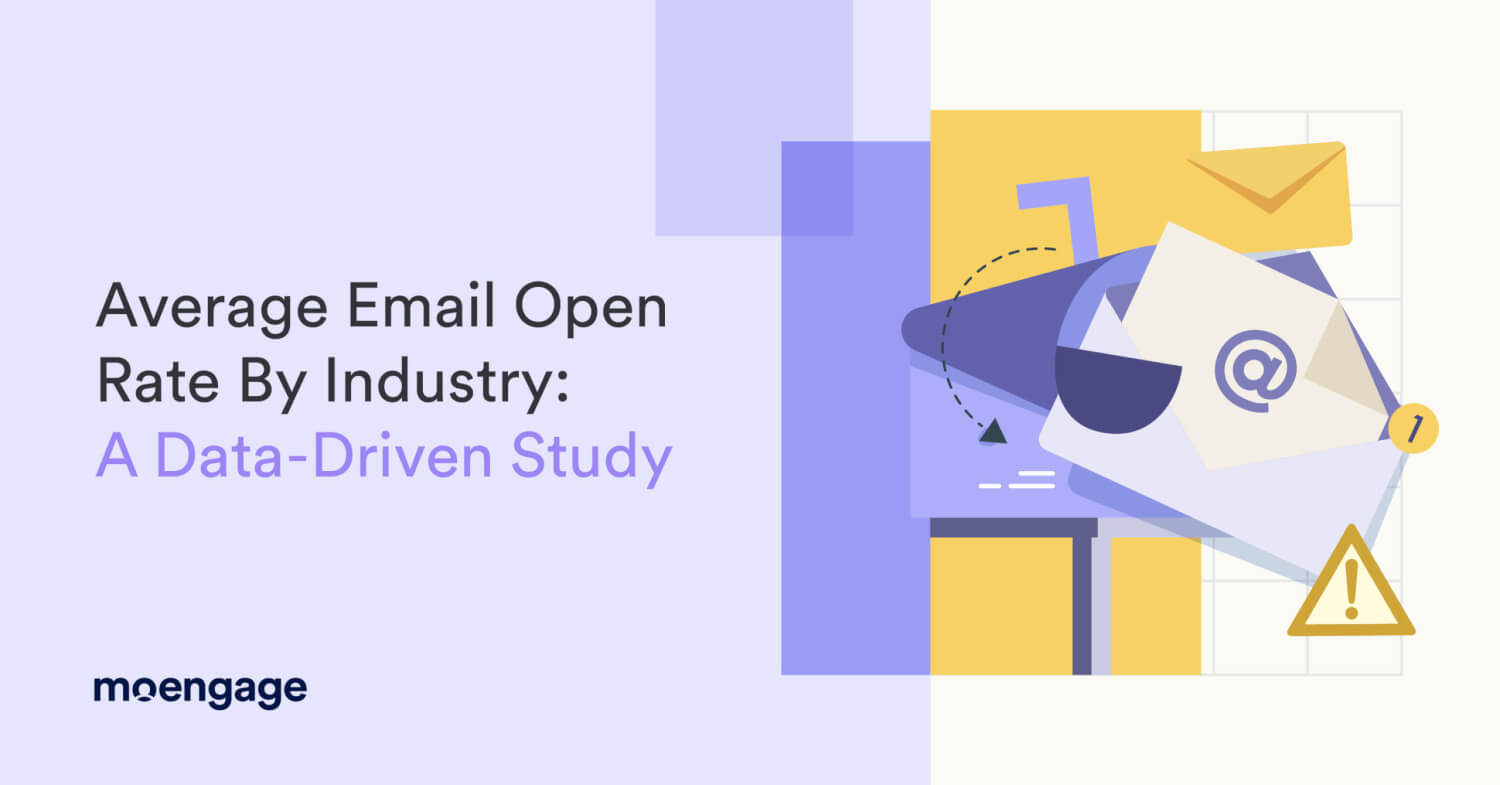
Reading Time: 12 minutes
Irrespective of the industry, most brands leverage email as their primary channel to reach out to and engage their customers. However, the highly competitive business landscape coupled with the overwhelming volume of daily emails customers receive, means that very few emails actually make the cut when it comes to capturing customer attention.
So, what does this mean for email marketing in general?
At MoEngage, we did a detailed study of over 17 billion emails across multiple industries to see which factors contributed to higher engagement in emails. We derived the industry averages for key email performance metrics and did a detailed analysis to uncover how brands can improve their email campaigns to increase customer engagement and conversions.
In this blog, we’ll walk you through the key findings from our report and what they mean for you.
What is the average open rate for email marketing?
The Email Benchmarks Report reveals that the average open rate for email marketing is 28.6%, with the lowest open rate being 14.5% and the highest being 42.4%.
Email open rates are typically calculated by dividing the total number of emails opened by the number of emails successfully delivered to your recipients.
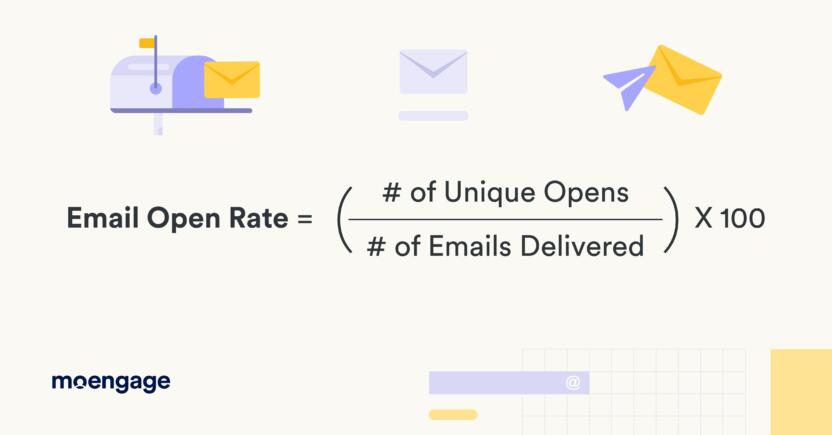
They are largely influenced by factors like email type, campaign strategy, and industry.
Behavior-based emails, for instance, have open rates as high as 42.36% while broadcast emails see only between 14.5% – 26.9% opens. In industries like retail, ecommerce, and financial services, open rates are higher when emails are tailored to the customer journey or behavior, rather than generic ones.
Aside from this, open rates can also vary by device (mobiles or desktops), the customer experience across different platforms, the timing and frequency of campaigns, subject lines, etc.
A good way to increase your open rates and ultimately, the success of your email campaigns, is to leverage advanced analytical tools to learn more about audience behavior. You can use these insights to create personalized and targeted campaigns that truly resonate with subscribers .
What is the average click-to-open rate for email (CTOR)?
The report also gave us insights into the average email click-to-open rate (CTOR). It stands at around 14.1%, ranging from a low of 13.4% for the Financial Services industry to a high of 15.25% for the Media & Entertainment industry.
CTOR is the percentage of customers that both open an email and click a link in that email.
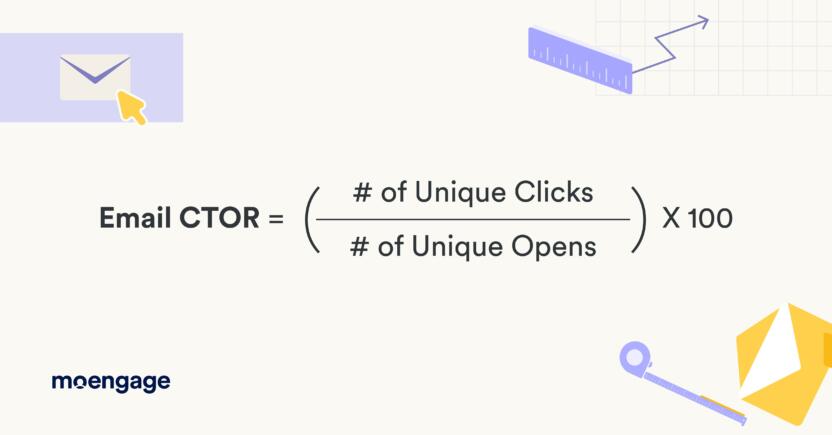
This metric allows brands to compare the number of customers that click a link to the number of customers that open them. It also helps them analyze customer engagement with their email campaigns.
What is the average conversion rate for email?
The average email conversion rate is 12.04%. It ranges from a low of 2.7% for the Retail & Ecommerce industry and to a high of 21.3% for the Financial Services industry.
The email conversion rate is the percentage of customers that complete a conversion event out of the number of email recipients.
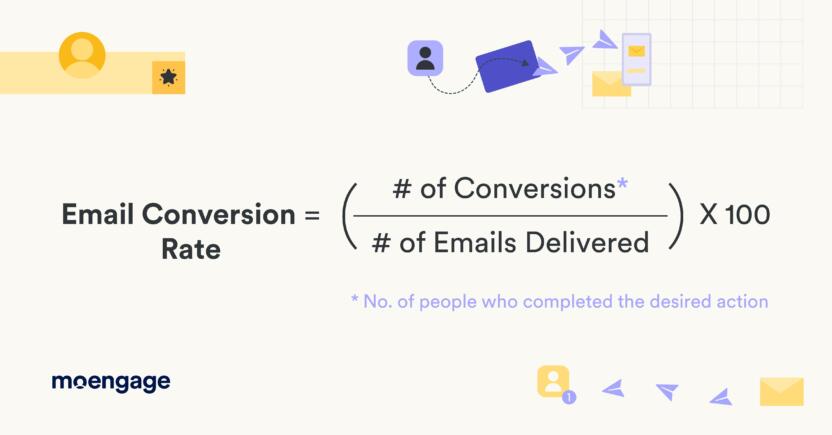
It represents the email campaign’s ability to get customers to complete an intended action, whether that be a completed purchase, renewed subscription, or even an app download or newsletter opt-in. Most notably, email conversion rates are used to measure the ability of your email campaigns to actually generate sales.
What is the average unsubscribe rate for email?
The average email unsubscribe rate is 0.82%. It ranges from a low of 0.23% for the Financial Services industry to a high of 1.98% for the Media & Entertainment industry.
The email unsubscribe rate is the percentage of customers that unsubscribe from a brand’s email list out of the total number of customers that are subscribed.
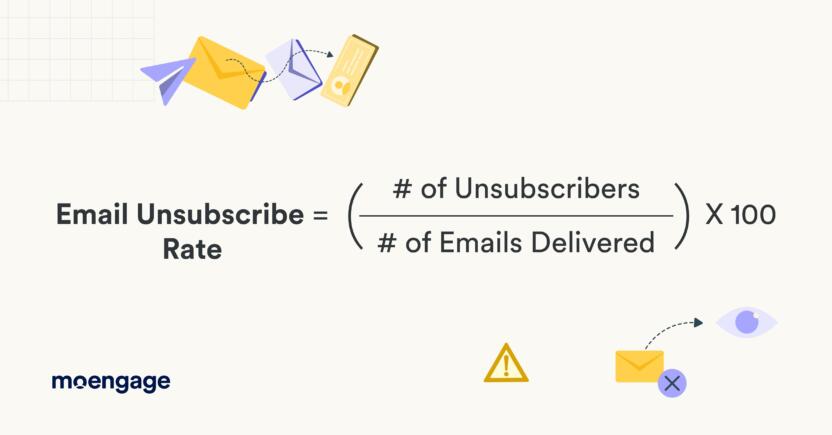
It represents customer dissatisfaction with a brand’s email campaign, but it doesn’t necessarily indicate why they are dissatisfied. However, brands can analyze when this drop-off occurs to better understand what led to this instance of churn. Accordingly, they can implement a targeted reactivation campaign via omnichannel marketing.
Email Open Rates By Industry for Retail & Ecommerce, Finance, & Media
Email open rates are among the most important metrics to analyze for your campaign strategy, simply because they give you a snapshot of the campaign’s success. However, the benchmarks for different industries often differ.
In the report, we bifurcated email marketing performance to derive industry-level benchmarks for Retail & Ecommerce, Financial Services, and Media & Entertainment.
Based on our findings, the average email open rates are as follows:
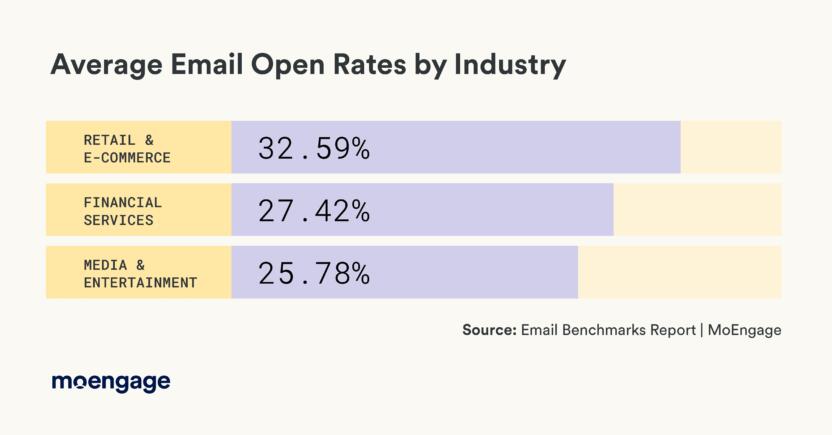
Now let’s explore how you can use these industry averages to tweak your email campaign strategy.
1. Retail & Ecommerce Average Email Open Rate: 32.59%
Email has been and continues to be the primary channel for communication between Retail and Ecommerce brands and their customers. But with time, the efficacy of generic, broadcast emails has worn out. Instead, businesses need to think about how they can stand out in a crowded online marketplace.
This is evident in the fact that the average open rate for broadcast emails is 26.59%, which is much lower than the industry average of 32.59%. However, adding attribute, behavior, and journey-based personalization to emails can improve the open rate by 20-40%.
In fact, personalization can help email open rates reach as high as 37.04% open rates.
A closer look also reveals that behavior-based personalization of emails has the most impact across all key metrics: open rates, CTOR, and conversion rates.
In comparison, journey-based personalization improves conversion rates significantly, but the impact on CTOR is not as high as that of the other email types. Similarly, attribute-based personalization increases CTOR significantly, but it’s not the same case for metrics like conversion rates.
Key takeaways for email open rates for retail & ecommerce:
- Broadcast emails perform less than ideal for all metrics, with a 26.9% open rate, a low CTOR of 1.1%, and a conversion rate of just 0.09%.
- With a 37.04% open rate, 25.5% click-to-open rate, and 5.5% conversion rate, behavior-based emails have the greatest impact on email campaigns across the board. However, they can be a double-edged sword with the highest risk of an unsubscription among all personalization types, if emails are sent too frequently or sound intrusive.
- Conversion rates saw the greatest uplift due to personalization, with a 60.7x increase for behavior-based personalization compared to broadcast emails. This was followed closely by journey-based personalization which increased conversions by 55.9x.
- It’s safe to say that Retail & Ecommerce marketers will benefit from leading with behavior-based personalization when it comes to maximizing email engagement.
Example strategy for behavior-based emails for retail & ecommerce
We saw that behavior-based emails had the greatest impact on email metrics, leading to a whopping 60.7x increase in conversion rates.
Crafting behavioral-based emails that get triggered by a customer’s specific actions is a great way to improve customer experience, if timed correctly and without seeming too pushy.
When you send customers emails in real time, with recommendations that are relevant to what they’ve been searching for or actions that they’ve recently taken, the message is far more likely to resonate with them. The more relevant your recommendations, the higher the chances of a conversion or sale.
Nike often uses behavior-based personalization to get conversions. Say a customer is on the hunt for a pair of running shoes and adds their find to the cart but doesn’t complete the purchase. This immediately triggers an email nudging them to complete their purchase.
As you can see in the email below, Nike is sending a cart reminder and offering free shipping to encourage the customer to sign up for a membership. It also includes a few other recommendations based on the customer’s past behavior, browsing history, and budget, in case they’re looking for something better.

2. Banking & Finance Average Email Open Rate: 27.42%
Banks and other financial services operate in very regulated environments. Communication can be sensitive, with customers expecting emails and messages to be compliant with regulations and highly relevant. Sending generic emails not only poses the risk of unsubscriptions but can also have an impact on your credibility.
The average email open rate for financial services is around 27.42%. Behavior-based personalization leads to the highest opens (42.36%) and CTOR (21.64%), and the lowest unsubscribe rates (0.13%). It performs the best in terms of improving metrics across the board. Since these emails are based on the customer’s banking needs or wealth management goals showcased by their real-time behavior, it makes them highly relevant.
On the other hand, the data also shows that journey-based personalization provides the highest conversion rates amongst all personalization types. This is because such emails are tailored to specific customer journey stages: awareness, decision (e.g. when they download the app), purchase (e.g. when they make an investment like a fixed deposit), retention, and advocacy.
Key takeaways for email open rates in banking and finance:
- Broadcast emails have an open rate of 14.5%, a CTOR of 6.1%, and a conversion rate of 9.5%, which is lower than other email types and also the industry average.
- Attribution-based emails fare better than broadcast emails, with double the conversion rates, but they aren’t as effective in terms of open rates and CTOR.
- Behavior-based emails perform the best across most metrics. They also have a strong conversion rate of 26.5% which is almost 3x higher than broadcast messages.
- With a conversion rate of 29.2% journey-based emails outperform all the other email types in this industry. A clear indicator that aligning your messages with the customer’s journey has a significant impact on decision-making.
- Both journey-based and behavior-based emails showed the greatest impact across the board. This is why BFSI marketers should lead with journey-based emails but complement them with a behavior-based strategy for the best results.
Example strategy for journey-based emails for banking & finance
Journey-based personalization drives the highest conversions in the Financial Services industry. And there are various ways to integrate this kind of personalization into your email strategy. Some brands send out onboarding and welcome emails to introduce new customers to their services. Others send it out based on whether the customer is ready to become a brand advocate.
Look at how the United Bank for Africa does it, for instance.
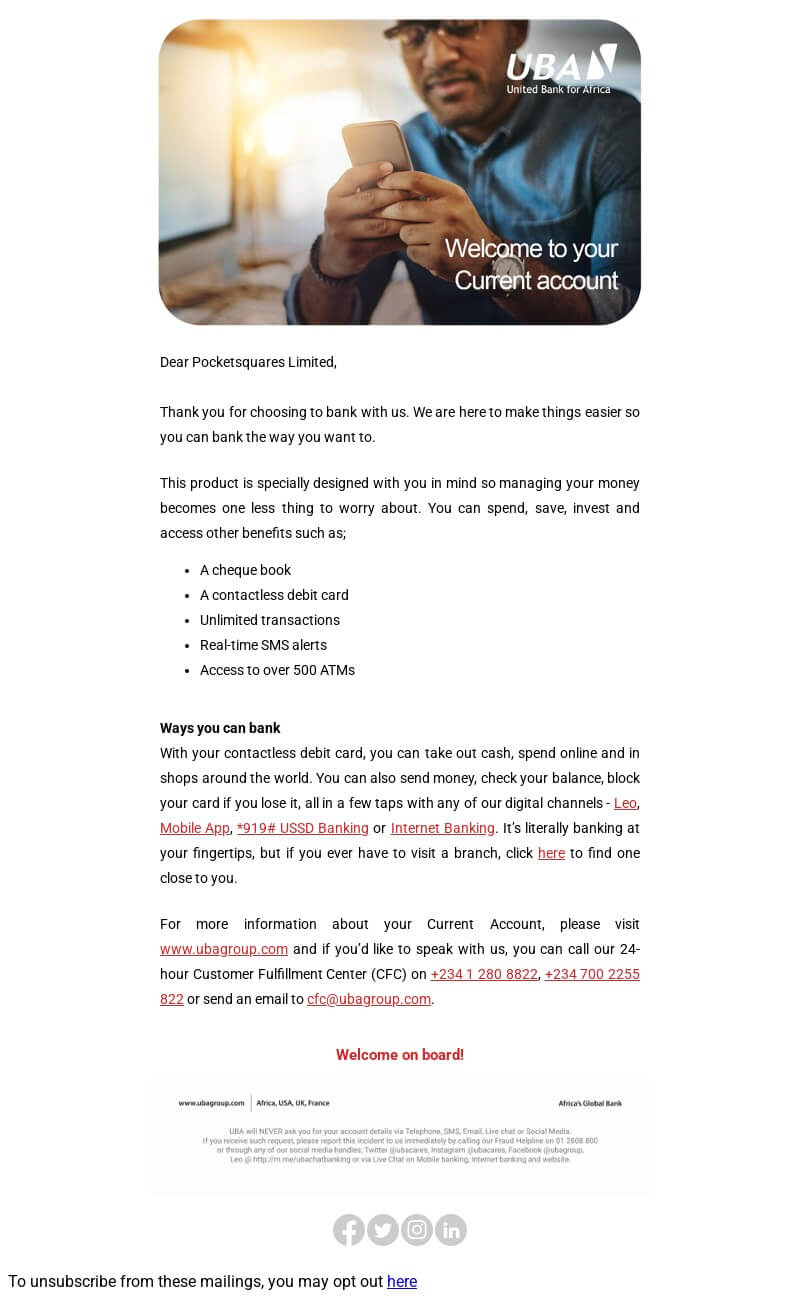
This is an example of a well-framed welcome email sent to a newly onboarded customer. It clearly highlights how their account is going to help them manage money. Aside from this, UBA has also included everything that the customer can do with their new debit card. The email also guides the customer to the nearest branch and mentions their 24-hour support hotline in case they need it.
All these steps play a key role in educating the customer and ensuring that they feel confident in accessing help. This allows the customer to complete their onboarding and make the best use of their account, reducing the likelihood of drop-offs.
3. Media & Entertainment Average Email Open Rate: 25.78%
The Media & Entertainment industry thrives on monetizing customer experiences. You have streaming services, ticketing platforms, news platforms, and several other digital content providers vying for the customer’s attention. Again, personalization is critical here if you want to stand out against the high content saturation and continue getting ROI.
Our research shows that the average email open rate for the Media & Entertainment industry is 25.8%. Behavior-based emails once again show the highest CTOR and open rates while journey-based emails have the highest conversion rate.
In terms of unsubscribe rates, the Media & Entertainment industry has the widest range, with broadcast emails leading to 6.4% unsubscribes and journey-based emails reducing it to 0.15%. This goes to show how customers in this industry are highly-sensitive to the kind of marketing communication they receive. If it’s not personalized and made relevant to their preferences and journey stage, they’ll not take even a second to hit the unsubscribe button.
Key takeaways for email open rates in Media & Entertainment:
- Broadcast emails have an open rate of 15.1% and extremely poor CTOR and conversion rate, in comparison to other email types and industry benchmarks.
- Attribution-based emails are still better than broadcast emails when it comes to open rate and CTOR, but still fall behind with conversions
- Behavior-based and journey-based personalization have the greatest impact, but on different metrics.
- Behavior-based personalization significantly increased open rates (39.7%) and CTORs (26.5%), whereas journey-based personalization significantly improved conversion rates (42.1%) and unsubscribe rates (0.2%).
Example strategy for behavior-based emails for Media & Entertainment
Crafting behavior-based emails for customers in the Media & Entertainment industry hinges on observing their current and past actions, such as their viewing history or a new playlist they favorited. Based on these insights you can send them relevant content recommendations, re-engagement emails (for inactive users), and special offers for upselling or cross-selling.
To illustrate this better, let’s take the example of Spotify. The platform looks at customer analytics to find out more about their users’ listening habits, preferred genres, and favorite artists. They then use this information to send very specific emails to their users whenever a relevant show or album is launched. This way they guide their users to use the Spotify app for more than just listening to music but also discovering live events and concerts nearby by their favorite artists/bands. This helps them close the entire journey loop and boosts customer retention.

These are just some of the findings in our Email Benchmarks Report. But we unpack so much more in this report, including in-depth insights on:
- Email deliverability benchmarks to keep an eye on
- When to send your emails so that customers are most likely to open them or convert
- Best practices to help you optimize your email campaigns
- Pro tips from industry experts from Inbox Monster and Movable Ink
5 Other Average Email Open Rate Studies For More Information
Since email performance continues to be a source of constant evaluation and improvement, it’s always a good idea to have access to as many resources as possible. We’ve compiled a list of five other email open rate studies you can refer to, if you need more information on how to drive maximum results from your email campaigns.
1. Email Marketing Benchmarks and Metrics Businesses Should Track | Mailchimp
This report gives you insights into the email benchmarks such as average email open rates, across multiple industries (including consulting, business and finance, and creative services). You can simply select the industry you want to analyze from the drop-down provided on the page to get the benchmarks for your industry. Even though these metrics aren’t analyzed in-depth, Mailchimp’s report provides various strategies to execute email marketing.
2. Email Open Rates By Industry (& Other Top Email Benchmarks) | HubSpot
This is a consolidated report of the average email open rates and other metrics sourced from a number of other studies (such as Mailchimp, Constant Contact, Mailerlite, Omnisend, GetResponse). It gives you a holistic view of email performance. However, since this is based on secondary data, you must look at the benchmarks with a pinch of salt.
3. Average open, click, and bounce rates of Constant Contact customers by industry | Constant Contact
Constant Contact provides an updated list of average email open rates, CTRs, and bounce rate benchmarks for different industries, based on its customer data. The report is updated frequently so you will always get access to the updated data. However, the report does not cover any other email metrics or the implications of the metrics shown.
4. Email, SMS, and push marketing statistics for ecommerce in 2024 | Omnisend
Omnisend’s report includes data based on the analysis of the performance of all the email campaigns sent by their merchants across multiple channels in 2023. It compares different email metrics for different industries and also includes insights on the performance of automated emails against campaign emails. However, these insights are applicable only to the ecommerce industry.
5. What are good open rates, CTRs, & CTORs for email campaigns? | CampaignMonitor
If you want a breakdown of the average open rates, CTRs, and CTORs across industries, regions, and days, this can be a good resource to refer to. It also offers a handy email revenue calculator to help you calculate the potential ROI from your campaigns. However, the biggest drawback is that this report just covers benchmarks for 2022.
Exceed Average Email Open Rates with MoEngage
One of the biggest takeaways from this year’s Email Benchmarks Report is the decrease in open rates when we do a Year-on-Year comparison. This is suggestive of the fact that consumers are becoming more reluctant to open emails and screening them more diligently than ever before.
Aside from this, unsubscribe rates are also on the rise, meaning that customers are quick to drop-off from mailing lists of brands that don’t offer them any value.
On the other hand, the significant uptick in CTOR and conversion rates suggests that when emails are personalized the right way and timed correctly, they can be quite effective in driving engagement and increasing conversions. It can also have a huge impact on bringing unsubscribe rates down, in the long run.
Keeping this in mind, it’s time to rethink your email strategy and your email tech provider. If you want to meet and beat the industry benchmarks for email performance, you’ll need to focus on crafting emails that are personalized based on real-time customer insights on behavior and journey.
A customer engagement platform like MoEngage can help you leverage customer-friendly analytics and advanced segmentation to build and execute highly personalized email campaigns that resonate with your audience. Interested to know more?
Book a demo now with our customer engagement experts.








